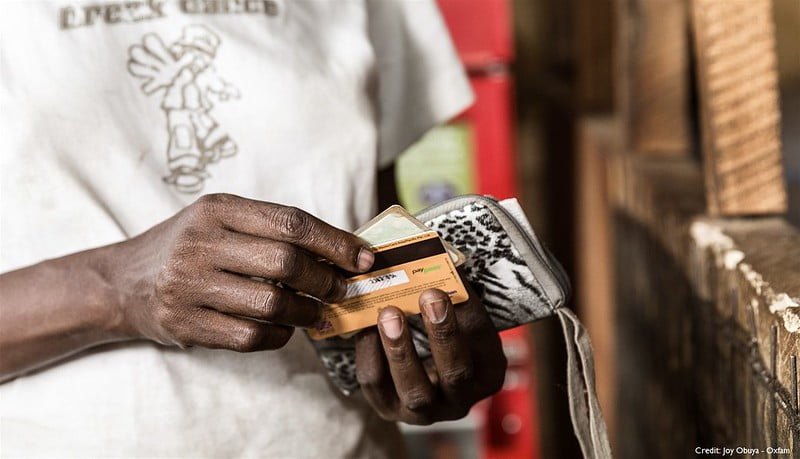Cash Transfers: Progress made but challenges remain

The expansion has been made possible by new technology. In the drought prone area of East Africa, where banks are few and far between, cash programming would once have meant setting up payout centres and the recipients having to travel considerable distances to collect their money. Now, thanks to ‘mobile money’ services like M-Pesa, the transfers can be sent direct to recipients’ mobile phones and the cash picked up from their nearest agent.
Scams and exclusion
Christopher Foster, from Oxford University’s Internet Institute, has been doing a study of how the mobile phone transfers have been working in Kenya. He says that, as you might expect, it has a number of advantages. It is cheap, because it uses the already existing network of mobile phone agents. It’s easy to reach scattered recipients over a wide area, as long as they have mobile phone coverage, and most of the recipients find it convenient and more dignified than coming to a central distribution point to get assistance. Organisations running the programmes no longer have to handle large amounts of cash, and it avoids the situation where people leave a central distribution point carrying sums of money, becoming a magnet for thieves.
Even so, says Foster, it is not totally secure. “There’s always this idea that if you use mobile transfers that there’s no problem of security; it’s all gone. But that’s not necessarily the case. In one of the cases I’ve looked at, one of the problems they’ve had is that a lot of people gave the wrong numbers, so the money got sent to the wrong people. Also some recipients, especially more vulnerable people, had problems with scams; they got messages saying they had won the lottery, or telling them to send something to this number, and they ended up sending the money on.”
Foster also worries about the more vulnerable in general. “In terms of exclusion, there are still some elderly or disabled people who can’t make it to an agent, and also people like immigrants, or anyone undocumented, because these systems all require some recent form of documentation. In one of the trials, up to 26% of the recipients had to use nominees, other people, to collect the money for them because they couldn’t access the service.” The risk is that, while phone transfers are cheap and convenient for the implementing agencies, they could just shift the costs and risks further down the chain, onto people less able to bear them.
One voucher, one card?
Rural East Africa, with its scattered, unbanked population, has been one major test bed for new methods of cash transfer programming. Another has been the Syrian refugees who have poured across the borders into Jordan, Lebanon and Turkey. These recipients are living in urban societies with all the attributes of a functioning modern state – banks, cash machines and supermarkets. WFP rules specify that their assistance must be spent on food, but it is giving refugees vouchers which can be spent in normal shops, and exchanged for any food item apart from sweets and fizzy drinks.
The current refugee operation in the Middle East is using cash assistance, not just for food, but for winter heating payments, help with rent and all kinds of other needs. And cash doesn’t have to mean banknotes, coins or paper vouchers; the beneficiaries are just as likely to get their money loaded electronically onto various kinds of plastic cards. In Turkey, Jordan and Lebanon, like other upper or middle income countries, there has been a move in recent years away from physical cash and towards different kinds of cashless, electronic payment. The world of humanitarian assistance has to keep up.
This financial sophistication gives the many agencies working with Syrian refugees a wide choice of potential partners for aid delivery, and that has resulted in a baffling range of different ways to access help. Researchers from Britain’s Overseas Development Institute (ODI) who looked at these partnerships in Jordan ended up making a strong plea for rationalisation. (Humanitarian crises, emergency preparedness and response: the role of business and the private sector – Jordan case study)
“Some banks require extensive documentation from cash recipients; others receive none…. Some cash cards are one-off (for winterisation, for instance, or the start of the school year), while others can be topped up. Some involve cards and PIN codes, while others are based on retinal scans. Some can be used to take out cash, while others can only be used in particular shops.” This, they say, “will create confusion among the refugees, who may not be able to keep track of multiple different cash cards, PIN codes and electronic vouchers, while also creating greater opportunities for abuse.”
It would make sense if all the agencies could all use the same system, but that might have far-reaching implications for the way aid is delivered. “The logical implication”, says ECHO’s Julia Stewart-David, “is that if you look at more cash-transfer programming, you have less specialist need to have ‘x’ or ‘y’ product-based assistance delivered. So why would you need as many actors as you have, if you can put it all on one card? Of course you need people who are specialists in WASH, or specialists in food assistance or health to do other parts of the assistance framework or the guidelines or the advocacy. But the actual delivery – you wouldn’t need UNHCR to do one bit and WFP to do another bit. It could all be done on one voucher, one card.”
A version of this article first appeared on IRIN News – www.IRINnews.org
Main image: Joy Obuya/Oxfam


